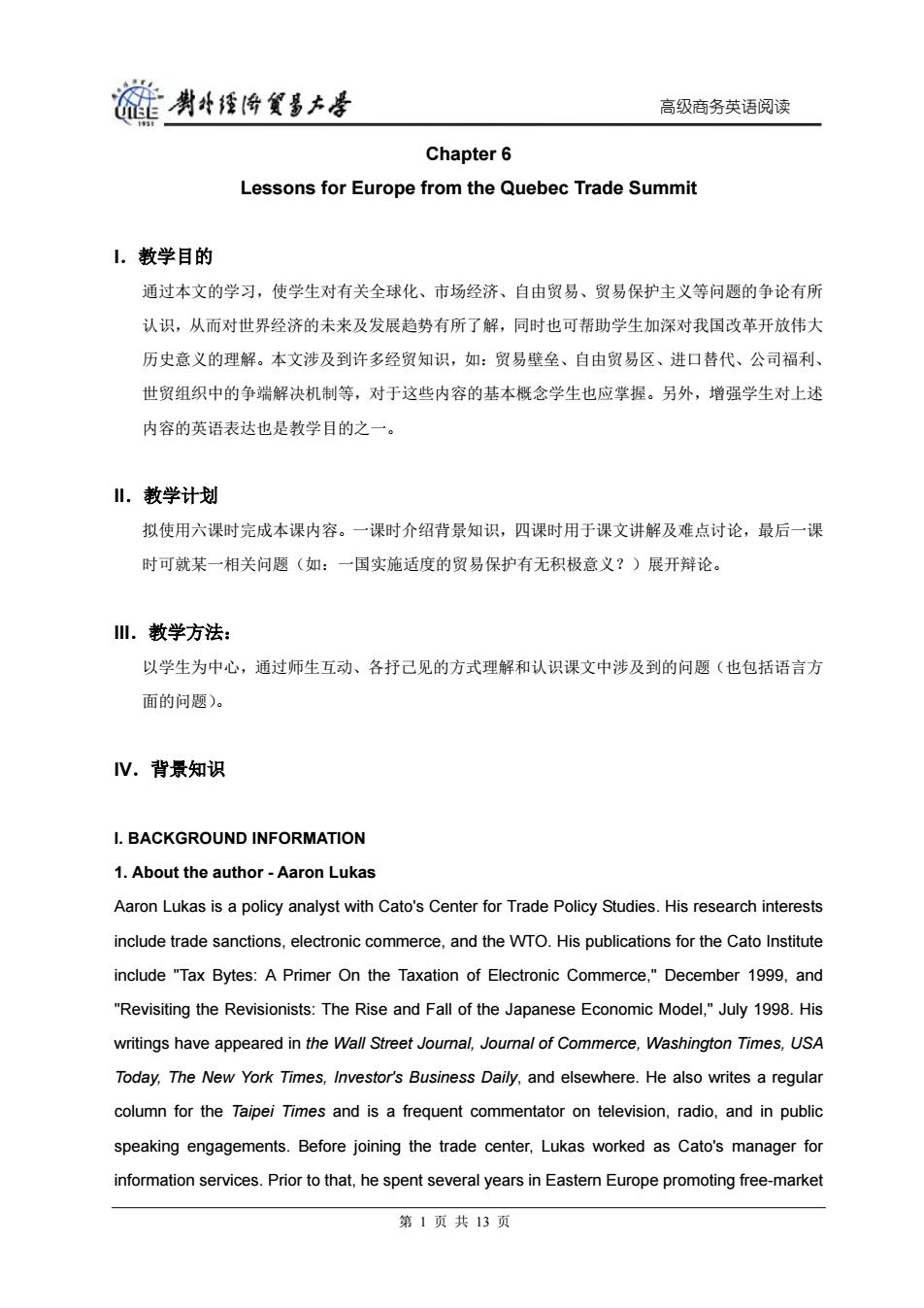
莲喇母矮将贸多大学 高级商务英语阅读 Chapter 6 Lessons for Europe from the Quebec Trade Summit 1.教学目的 通过本文的学习,使学生对有关全球化、市场经济、自由贸易、贸易保护主义等问题的争论有所 认识,从而对世界经济的未来及发展趋势有所了解,同时也可帮助学生加深对我国改革开放伟大 历史意义的理解。本文涉及到许多经贸知识,如:贸易壁垒、自由贸易区、进口替代、公司福利、 世贸组织中的争端解决机制等,对于这些内容的基本概念学生也应掌握。另外,增强学生对上述 内容的英语表达也是教学目的之一。 Ⅱ.教学计划 拟使用六课时完成本课内容。一课时介绍背景知识,四课时用于课文讲解及难点讨论,最后一课 时可就某一相关问题(如:一国实施适度的贸易保护有无积极意义?)展开辩论。 川.教学方法: 以学生为中心,通过师生互动、各抒己见的方式理解和认识课文中涉及到的问题(也包括语言方 面的问题)。 IV.背景知识 I.BACKGROUND INFORMATION 1.About the author-Aaron Lukas Aaron Lukas is a policy analyst with Cato's Center for Trade Policy Studies.His research interests include trade sanctions,electronic commerce,and the WTO.His publications for the Cato Institute include "Tax Bytes:A Primer On the Taxation of Electronic Commerce,"December 1999,and "Revisiting the Revisionists:The Rise and Fall of the Japanese Economic Model,"July 1998.His writings have appeared in the Wall Street Journal,Journal of Commerce,Washington Times,USA Today,The New York Times,Investor's Business Daily,and elsewhere.He also writes a regular column for the Taipei Times and is a frequent commentator on television,radio,and in public speaking engagements.Before joining the trade center,Lukas worked as Cato's manager for information services.Prior to that,he spent several years in Eastern Europe promoting free-market 第1页共13页
高级商务英语阅读 Chapter 6 Lessons for Europe from the Quebec Trade Summit I.教学目的 通过本文的学习,使学生对有关全球化、市场经济、自由贸易、贸易保护主义等问题的争论有所 认识,从而对世界经济的未来及发展趋势有所了解,同时也可帮助学生加深对我国改革开放伟大 历史意义的理解。本文涉及到许多经贸知识,如:贸易壁垒、自由贸易区、进口替代、公司福利、 世贸组织中的争端解决机制等,对于这些内容的基本概念学生也应掌握。另外,增强学生对上述 内容的英语表达也是教学目的之一。 II.教学计划 拟使用六课时完成本课内容。一课时介绍背景知识,四课时用于课文讲解及难点讨论,最后一课 时可就某一相关问题(如:一国实施适度的贸易保护有无积极意义?)展开辩论。 III.教学方法: 以学生为中心,通过师生互动、各抒己见的方式理解和认识课文中涉及到的问题(也包括语言方 面的问题)。 IV.背景知识 I. BACKGROUND INFORMATION 1. About the author - Aaron Lukas Aaron Lukas is a policy analyst with Cato's Center for Trade Policy Studies. His research interests include trade sanctions, electronic commerce, and the WTO. His publications for the Cato Institute include "Tax Bytes: A Primer On the Taxation of Electronic Commerce," December 1999, and "Revisiting the Revisionists: The Rise and Fall of the Japanese Economic Model," July 1998. His writings have appeared in the Wall Street Journal, Journal of Commerce, Washington Times, USA Today, The New York Times, Investor's Business Daily, and elsewhere. He also writes a regular column for the Taipei Times and is a frequent commentator on television, radio, and in public speaking engagements. Before joining the trade center, Lukas worked as Cato's manager for information services. Prior to that, he spent several years in Eastern Europe promoting free-market 第 1 页 共 13 页
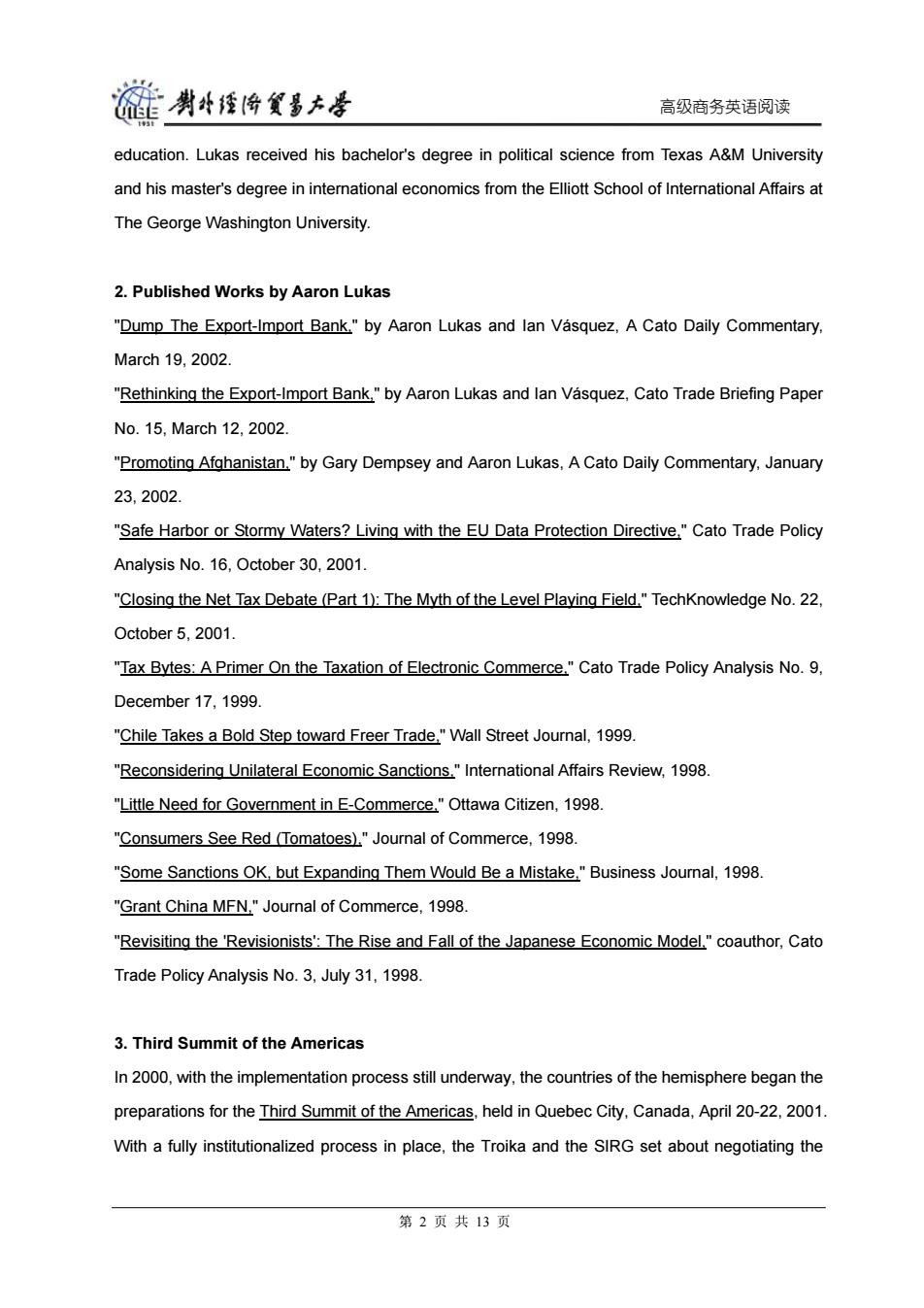
雒剥经降置昌大号 高级商务英语阅读 education.Lukas received his bachelor's degree in political science from Texas A&M University and his master's degree in international economics from the Elliott School of International Affairs at The George Washington University. 2.Published Works by Aaron Lukas "Dump The Export-Import Bank,"by Aaron Lukas and lan Vasquez,A Cato Daily Commentary, March 19.2002 "Rethinking the Export-Import Bank,"by Aaron Lukas and lan Vasquez,Cato Trade Briefing Paper No.15,March12,2002. "Promoting Afghanistan."by Gary Dempsey and Aaron Lukas,A Cato Daily Commentary,January 23,2002. "Safe Harbor or Stormy Waters?Living with the EU Data Protection Directive,"Cato Trade Policy Analysis No.16,October 30,2001. "Closing the Net Tax Debate (Part 1):The Myth of the Level Playing Field,"TechKnowledge No.22, October 5,2001. "Tax Bytes:A Primer On the Taxation of Electronic Commerce,"Cato Trade Policy Analysis No.9, December 17,1999 "Chile Takes a Bold Step toward Freer Trade,"Wall Street Journal,1999. "Reconsidering Unilateral Economic Sanctions."International Affairs Review,1998. "Little Need for Government in E-Commerce,"Ottawa Citizen,1998. "Consumers See Red (Tomatoes)."Journal of Commerce,1998. "Some Sanctions OK,but Expanding Them Would Be a Mistake,Business Journal,1998. "Grant China MFN,"Journal of Commerce,1998. "Revisiting the 'Revisionists':The Rise and Fall of the Japanese Economic Model,"coauthor,Cato Trade Policy Analysis No.3,July 31,1998. 3.Third Summit of the Americas In 2000,with the implementation process still underway,the countries of the hemisphere began the preparations for the Third Summit of the Americas,held in Quebec City,Canada,April 20-22,2001. With a fully institutionalized process in place,the Troika and the SIRG set about negotiating the 第2页共13页
高级商务英语阅读 education. Lukas received his bachelor's degree in political science from Texas A&M University and his master's degree in international economics from the Elliott School of International Affairs at The George Washington University. 2. Published Works by Aaron Lukas "Dump The Export-Import Bank," by Aaron Lukas and Ian Vásquez, A Cato Daily Commentary, March 19, 2002. "Rethinking the Export-Import Bank," by Aaron Lukas and Ian Vásquez, Cato Trade Briefing Paper No. 15, March 12, 2002. "Promoting Afghanistan," by Gary Dempsey and Aaron Lukas, A Cato Daily Commentary, January 23, 2002. "Safe Harbor or Stormy Waters? Living with the EU Data Protection Directive," Cato Trade Policy Analysis No. 16, October 30, 2001. "Closing the Net Tax Debate (Part 1): The Myth of the Level Playing Field," TechKnowledge No. 22, October 5, 2001. "Tax Bytes: A Primer On the Taxation of Electronic Commerce," Cato Trade Policy Analysis No. 9, December 17, 1999. "Chile Takes a Bold Step toward Freer Trade," Wall Street Journal, 1999. "Reconsidering Unilateral Economic Sanctions," International Affairs Review, 1998. "Little Need for Government in E-Commerce," Ottawa Citizen, 1998. "Consumers See Red (Tomatoes)," Journal of Commerce, 1998. "Some Sanctions OK, but Expanding Them Would Be a Mistake," Business Journal, 1998. "Grant China MFN," Journal of Commerce, 1998. "Revisiting the 'Revisionists': The Rise and Fall of the Japanese Economic Model," coauthor, Cato Trade Policy Analysis No. 3, July 31, 1998. 3. Third Summit of the Americas In 2000, with the implementation process still underway, the countries of the hemisphere began the preparations for the Third Summit of the Americas, held in Quebec City, Canada, April 20-22, 2001. With a fully institutionalized process in place, the Troika and the SIRG set about negotiating the 第 2 页 共 13 页
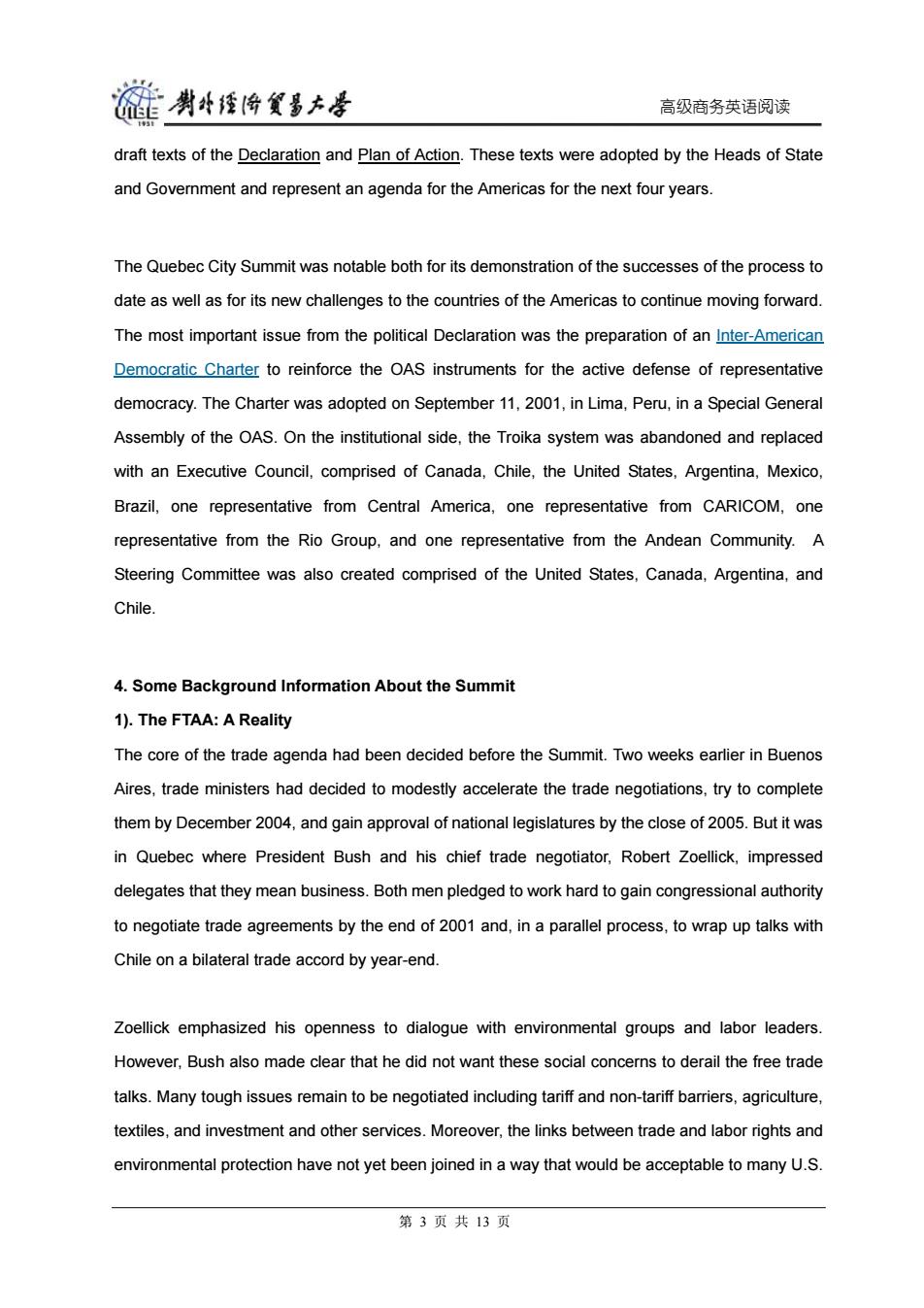
链剥头经将复多大是 高级商务英语阅读 draft texts of the Declaration and Plan of Action.These texts were adopted by the Heads of State and Government and represent an agenda for the Americas for the next four years. The Quebec City Summit was notable both for its demonstration of the successes of the process to date as well as for its new challenges to the countries of the Americas to continue moving forward. The most important issue from the political Declaration was the preparation of an Inter-American Democratic Charter to reinforce the OAS instruments for the active defense of representative democracy.The Charter was adopted on September 11,2001,in Lima,Peru,in a Special General Assembly of the OAS.On the institutional side,the Troika system was abandoned and replaced with an Executive Council,comprised of Canada,Chile,the United States,Argentina,Mexico, Brazil,one representative from Central America,one representative from CARICOM,one representative from the Rio Group,and one representative from the Andean Community.A Steering Committee was also created comprised of the United States,Canada,Argentina,and Chile. 4.Some Background Information About the Summit 1).The FTAA:A Reality The core of the trade agenda had been decided before the Summit.Two weeks earlier in Buenos Aires,trade ministers had decided to modestly accelerate the trade negotiations,try to complete them by December 2004,and gain approval of national legislatures by the close of 2005.But it was in Quebec where President Bush and his chief trade negotiator,Robert Zoellick,impressed delegates that they mean business.Both men pledged to work hard to gain congressional authority to negotiate trade agreements by the end of 2001 and,in a parallel process,to wrap up talks with Chile on a bilateral trade accord by year-end. Zoellick emphasized his openness to dialogue with environmental groups and labor leaders. However,Bush also made clear that he did not want these social concerns to derail the free trade talks.Many tough issues remain to be negotiated including tariff and non-tariff barriers,agriculture, textiles,and investment and other services.Moreover,the links between trade and labor rights and environmental protection have not yet been joined in a way that would be acceptable to many U.S. 第3页共13页
高级商务英语阅读 draft texts of the Declaration and Plan of Action. These texts were adopted by the Heads of State and Government and represent an agenda for the Americas for the next four years. The Quebec City Summit was notable both for its demonstration of the successes of the process to date as well as for its new challenges to the countries of the Americas to continue moving forward. The most important issue from the political Declaration was the preparation of an Inter-American Democratic Charter to reinforce the OAS instruments for the active defense of representative democracy. The Charter was adopted on September 11, 2001, in Lima, Peru, in a Special General Assembly of the OAS. On the institutional side, the Troika system was abandoned and replaced with an Executive Council, comprised of Canada, Chile, the United States, Argentina, Mexico, Brazil, one representative from Central America, one representative from CARICOM, one representative from the Rio Group, and one representative from the Andean Community. A Steering Committee was also created comprised of the United States, Canada, Argentina, and Chile. 4. Some Background Information About the Summit 1). The FTAA: A Reality The core of the trade agenda had been decided before the Summit. Two weeks earlier in Buenos Aires, trade ministers had decided to modestly accelerate the trade negotiations, try to complete them by December 2004, and gain approval of national legislatures by the close of 2005. But it was in Quebec where President Bush and his chief trade negotiator, Robert Zoellick, impressed delegates that they mean business. Both men pledged to work hard to gain congressional authority to negotiate trade agreements by the end of 2001 and, in a parallel process, to wrap up talks with Chile on a bilateral trade accord by year-end. Zoellick emphasized his openness to dialogue with environmental groups and labor leaders. However, Bush also made clear that he did not want these social concerns to derail the free trade talks. Many tough issues remain to be negotiated including tariff and non-tariff barriers, agriculture, textiles, and investment and other services. Moreover, the links between trade and labor rights and environmental protection have not yet been joined in a way that would be acceptable to many U.S. 第 3 页 共 13 页
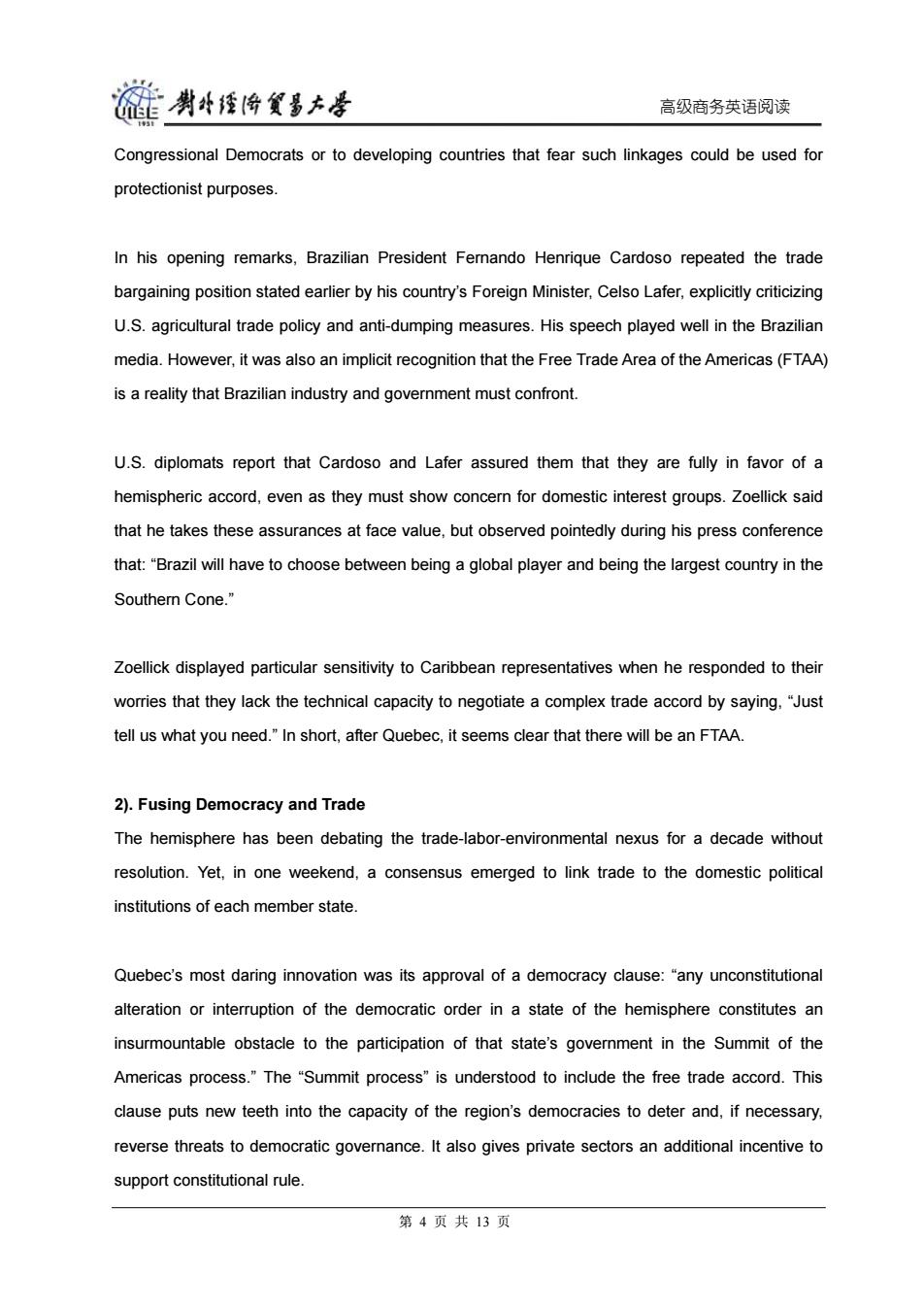
爸剥撞降餐多大学 高级商务英语阅读 Congressional Democrats or to developing countries that fear such linkages could be used for protectionist purposes. In his opening remarks,Brazilian President Fernando Henrique Cardoso repeated the trade bargaining position stated earlier by his country's Foreign Minister,Celso Lafer,explicitly criticizing U.S.agricultural trade policy and anti-dumping measures.His speech played well in the Brazilian media.However,it was also an implicit recognition that the Free Trade Area of the Americas(FTAA) is a reality that Brazilian industry and government must confront. U.S.diplomats report that Cardoso and Lafer assured them that they are fully in favor of a hemispheric accord,even as they must show concern for domestic interest groups.Zoellick said that he takes these assurances at face value,but observed pointedly during his press conference that:"Brazil will have to choose between being a global player and being the largest country in the Southern Cone." Zoellick displayed particular sensitivity to Caribbean representatives when he responded to their worries that they lack the technical capacity to negotiate a complex trade accord by saying,"Just tell us what you need."In short,after Quebec,it seems clear that there will be an FTAA. 2).Fusing Democracy and Trade The hemisphere has been debating the trade-labor-environmental nexus for a decade without resolution.Yet,in one weekend.a consensus emerged to link trade to the domestic political institutions of each member state Quebec's most daring innovation was its approval of a democracy clause:"any unconstitutional alteration or interruption of the democratic order in a state of the hemisphere constitutes an insurmountable obstacle to the participation of that state's government in the Summit of the Americas process."The "Summit process"is understood to include the free trade accord.This clause puts new teeth into the capacity of the region's democracies to deter and,if necessary, reverse threats to democratic governance.It also gives private sectors an additional incentive to support constitutional rule. 第4页共13页
高级商务英语阅读 Congressional Democrats or to developing countries that fear such linkages could be used for protectionist purposes. In his opening remarks, Brazilian President Fernando Henrique Cardoso repeated the trade bargaining position stated earlier by his country’s Foreign Minister, Celso Lafer, explicitly criticizing U.S. agricultural trade policy and anti-dumping measures. His speech played well in the Brazilian media. However, it was also an implicit recognition that the Free Trade Area of the Americas (FTAA) is a reality that Brazilian industry and government must confront. U.S. diplomats report that Cardoso and Lafer assured them that they are fully in favor of a hemispheric accord, even as they must show concern for domestic interest groups. Zoellick said that he takes these assurances at face value, but observed pointedly during his press conference that: “Brazil will have to choose between being a global player and being the largest country in the Southern Cone.” Zoellick displayed particular sensitivity to Caribbean representatives when he responded to their worries that they lack the technical capacity to negotiate a complex trade accord by saying, “Just tell us what you need.” In short, after Quebec, it seems clear that there will be an FTAA. 2). Fusing Democracy and Trade The hemisphere has been debating the trade-labor-environmental nexus for a decade without resolution. Yet, in one weekend, a consensus emerged to link trade to the domestic political institutions of each member state. Quebec’s most daring innovation was its approval of a democracy clause: “any unconstitutional alteration or interruption of the democratic order in a state of the hemisphere constitutes an insurmountable obstacle to the participation of that state’s government in the Summit of the Americas process.” The “Summit process” is understood to include the free trade accord. This clause puts new teeth into the capacity of the region’s democracies to deter and, if necessary, reverse threats to democratic governance. It also gives private sectors an additional incentive to support constitutional rule. 第 4 页 共 13 页
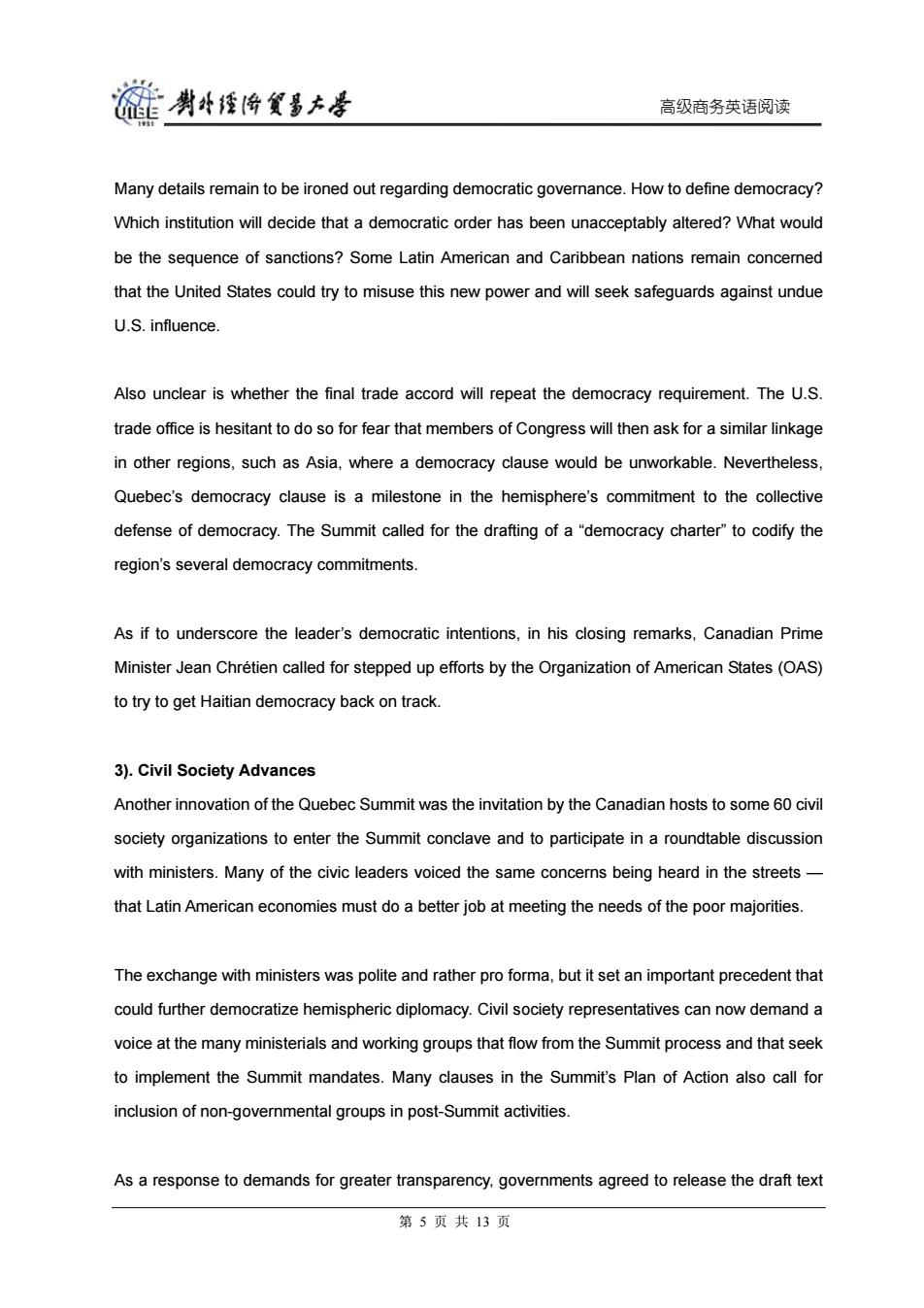
碰男华经净贸多大学 高级商务英语阅读 Many details remain to be ironed out regarding democratic governance.How to define democracy? Which institution will decide that a democratic order has been unacceptably altered?What would be the sequence of sanctions?Some Latin American and Caribbean nations remain concerned that the United States could try to misuse this new power and will seek safeguards against undue U.S.influence. Also unclear is whether the final trade accord will repeat the democracy requirement.The U.S. trade office is hesitant to do so for fear that members of Congress will then ask for a similar linkage in other regions,such as Asia,where a democracy clause would be unworkable.Nevertheless, Quebec's democracy clause is a milestone in the hemisphere's commitment to the collective defense of democracy.The Summit called for the drafting of a"democracy charter"to codify the region's several democracy commitments. As if to underscore the leader's democratic intentions,in his closing remarks,Canadian Prime Minister Jean Chretien called for stepped up efforts by the Organization of American States(OAS) to try to get Haitian democracy back on track. 3).Civil Society Advances Another innovation of the Quebec Summit was the invitation by the Canadian hosts to some 60 civil society organizations to enter the Summit conclave and to participate in a roundtable discussion with ministers.Many of the civic leaders voiced the same concerns being heard in the streets- that Latin American economies must do a better job at meeting the needs of the poor majorities. The exchange with ministers was polite and rather pro forma,but it set an important precedent that could further democratize hemispheric diplomacy.Civil society representatives can now demand a voice at the many ministerials and working groups that flow from the Summit process and that seek to implement the Summit mandates.Many clauses in the Summit's Plan of Action also call for inclusion of non-governmental groups in post-Summit activities. As a response to demands for greater transparency,governments agreed to release the draft text 第5页共13页
高级商务英语阅读 Many details remain to be ironed out regarding democratic governance. How to define democracy? Which institution will decide that a democratic order has been unacceptably altered? What would be the sequence of sanctions? Some Latin American and Caribbean nations remain concerned that the United States could try to misuse this new power and will seek safeguards against undue U.S. influence. Also unclear is whether the final trade accord will repeat the democracy requirement. The U.S. trade office is hesitant to do so for fear that members of Congress will then ask for a similar linkage in other regions, such as Asia, where a democracy clause would be unworkable. Nevertheless, Quebec’s democracy clause is a milestone in the hemisphere’s commitment to the collective defense of democracy. The Summit called for the drafting of a “democracy charter” to codify the region’s several democracy commitments. As if to underscore the leader’s democratic intentions, in his closing remarks, Canadian Prime Minister Jean Chrétien called for stepped up efforts by the Organization of American States (OAS) to try to get Haitian democracy back on track. 3). Civil Society Advances Another innovation of the Quebec Summit was the invitation by the Canadian hosts to some 60 civil society organizations to enter the Summit conclave and to participate in a roundtable discussion with ministers. Many of the civic leaders voiced the same concerns being heard in the streets — that Latin American economies must do a better job at meeting the needs of the poor majorities. The exchange with ministers was polite and rather pro forma, but it set an important precedent that could further democratize hemispheric diplomacy. Civil society representatives can now demand a voice at the many ministerials and working groups that flow from the Summit process and that seek to implement the Summit mandates. Many clauses in the Summit’s Plan of Action also call for inclusion of non-governmental groups in post-Summit activities. As a response to demands for greater transparency, governments agreed to release the draft text 第 5 页 共 13 页

喇牛煙将多大是 高级商务英语阅读 of the trade accord-a first in international trade negotiations.Privately,negotiators worried that more interest and advocacy groups will now be able to influence and perhaps slow the trade talks. Nevertheless,governments judged this as a cost worth paying to win wider support for the final trade accord. 4).Words Into Deeds? The Summit Plan of Action addressed many other social issues,including education;health;the digital divide;HIV/AIDS;and the rights of women,indigenous peoples,children,and migrants(the section on migrant rights was a victory for Mexican diplomacy).Leaders also urged more progress in combating corruption and narcotics. Where the Quebec Summit fell short was in planning for implementation.The 49-page, single-spaced Plan of Action contains too many pledges(over 260 action items)in proportion to the hemisphere's capacity to implement reforms.Too few initiatives have clear timetables,quantifiable targets,and monitoring mechanisms.Nor is it clear just where the necessary money will come from for many of these initiatives. Summit leaders did call for ministers of finance and their representatives in the resource-rich Inter-American Development Bank and World Bank to meet with those officials charged with Summit implementation.Efforts were made to streamline the management of summitry.An executive council and a smaller steering committee of past,present,and future Summit hosts were established.It is unclear,however,whether governments will provide the key OAS Office of Summit Follow-up with sufficient staff and financing to effectively monitor and evaluate the implementation of Summit mandates. So it is still too soon to judge who will be the final winners in Quebec.If the trade talks bear fruit;if the democracy clause deters would-be violators;if a new democratic diplomacy takes hold;and if the many social initiatives find funding-then all the peoples of the Americas will have been winners at the Quebec Summit. 5.People's Summit 第6页共13页
高级商务英语阅读 of the trade accord — a first in international trade negotiations. Privately, negotiators worried that more interest and advocacy groups will now be able to influence and perhaps slow the trade talks. Nevertheless, governments judged this as a cost worth paying to win wider support for the final trade accord. 4). Words Into Deeds? The Summit Plan of Action addressed many other social issues, including education; health; the digital divide; HIV/AIDS; and the rights of women, indigenous peoples, children, and migrants (the section on migrant rights was a victory for Mexican diplomacy). Leaders also urged more progress in combating corruption and narcotics. Where the Quebec Summit fell short was in planning for implementation. The 49-page, single-spaced Plan of Action contains too many pledges (over 260 action items) in proportion to the hemisphere’s capacity to implement reforms. Too few initiatives have clear timetables, quantifiable targets, and monitoring mechanisms. Nor is it clear just where the necessary money will come from for many of these initiatives. Summit leaders did call for ministers of finance and their representatives in the resource-rich Inter-American Development Bank and World Bank to meet with those officials charged with Summit implementation. Efforts were made to streamline the management of summitry. An executive council and a smaller steering committee of past, present, and future Summit hosts were established. It is unclear, however, whether governments will provide the key OAS Office of Summit Follow-up with sufficient staff and financing to effectively monitor and evaluate the implementation of Summit mandates. So it is still too soon to judge who will be the final winners in Quebec. If the trade talks bear fruit; if the democracy clause deters would-be violators; if a new democratic diplomacy takes hold; and if the many social initiatives find funding — then all the peoples of the Americas will have been winners at the Quebec Summit. 5. People’s Summit 第 6 页 共 13 页

链剥卧吟复男六号 高级商务英语阅读 The"Second People's Summit of the Americas"was organised in order to discuss the ramifications of the Free Trade Area of the Americas(FTAA)in regards to labour,environment and other social issues in the Hemisphere.The Peoples's Summit was held in Quebec City from April 17 to 21, 2001 which coincided with the Third Summit of the Americas.The two organisations responsible for organising the Summit were Reseau quebecois sur I'integration continentale (RQIC)and Common Frontiers,which represent two coalitions of labour unions,international co-operation organisations,environmental groups,research groups and other grassroots organisations.The attendees,for the most part,were members of the Hemispheric Social Alliance(HSA)which is a network of organisations and social movements.The objectives of the People's Summit were stated as follows: To inform and educate citizens on issues of market globalisation and,specifically.on the Santiago Action Plan and the Free Trade Area of the Americas(FTAA) To bring the FTAA issue into discussions within the various areas of civil society in order to foster critical analysis of the FTAA itself and its social,economic and political effects on our populations. To pursue our analysis of the project to integrate markets and its impact on societies, communities,economic policy,and social and environmental programs. To strengthen and consolidate the Hemispheric Social Alliance(HSA)on the organisational and political level,ensuring that it becomes an important advocate capable of making itself heard by our governments and societies. To make negotiations more transparent and democratic by promoting full access to all of the information available on the effects of market liberalisation on vulnerable populations and on social environments ● To pursue exchanges with members of the HSA on the one hand,and the public on the other. ● To pursue the analysis outlined in the Alternatives for the Americas document. To improve existing negotiating processes and the mechanics of consultations undertaken to date To make the Second Peoples'Summit of the Americas primary in the process of strengthening the Hemispheric Social Alliance. 6.About the Summit Demonstrations 第7页共13页
高级商务英语阅读 The "Second People’s Summit of the Americas" was organised in order to discuss the ramifications of the Free Trade Area of the Americas (FTAA) in regards to labour, environment and other social issues in the Hemisphere. The Peoples’s Summit was held in Quebec City from April 17 to 21, 2001 which coincided with the Third Summit of the Americas. The two organisations responsible for organising the Summit were Réseau québécois sur l'intégration continentale (RQIC) and Common Frontiers, which represent two coalitions of labour unions, international co-operation organisations, environmental groups, research groups and other grassroots organisations. The attendees, for the most part, were members of the Hemispheric Social Alliance (HSA) which is a network of organisations and social movements. The objectives of the People’s Summit were stated as follows: z To inform and educate citizens on issues of market globalisation and, specifically, on the Santiago Action Plan and the Free Trade Area of the Americas (FTAA). z To bring the FTAA issue into discussions within the various areas of civil society in order to foster critical analysis of the FTAA itself and its social, economic and political effects on our populations. z To pursue our analysis of the project to integrate markets and its impact on societies, communities, economic policy, and social and environmental programs. z To strengthen and consolidate the Hemispheric Social Alliance (HSA) on the organisational and political level, ensuring that it becomes an important advocate capable of making itself heard by our governments and societies. z To make negotiations more transparent and democratic by promoting full access to all of the information available on the effects of market liberalisation on vulnerable populations and on social environments. z To pursue exchanges with members of the HSA on the one hand, and the public on the other. z To pursue the analysis outlined in the Alternatives for the Americas document. z To improve existing negotiating processes and the mechanics of consultations undertaken to date. z To make the Second Peoples' Summit of the Americas primary in the process of strengthening the Hemispheric Social Alliance. 6. About the Summit Demonstrations 第 7 页 共 13 页

链喇4哈餐多方孝 高级商务英语阅读 During the April 20-22 Summit of the Americas held in Quebec City,Canadian authorities brought in 6,000 police officers from across Canada and circled the summit venue with a 2.3-mile concrete and chain-link fence to keep the demonstrators away from the regional leaders.More than 6,000 specially trained riot police were also on hand.Protesters also prepared for violence,bringing their own gas masks,helmets and padded clothing for protection.Protesters vehemently opposed a free trade agreement-which was high on the agenda of the summit of 34 Western Hemisphere leaders because they believed it would benefit only multinational corporations. On April 20,protesters clashed with police near the Summit of the Americas after the crowd tore down parts of a fence and barricades erected to keep them away from the conference in southeastern Canada.Riot police with helmets,batons and shields stood shoulder-to-shoulder trying to maintain their perimeter while demonstrators lobbed rocks,bottles and parts of the fence at the officers.Police answered with tear gas.Protesters picked up some of the tear gas canisters and tossed them back at police.The air soon grew hazy with the gas. V.课文讲解 概念讲解 anti-globalization 反全球化 trade barrier 贸易壁垒 flow of goods and capital 货物及资本流动 mercantilist assumptions 商业主义的观点 dispute settlement process 争端解决进程 课文注释 1.Quebec City(p.117) The capital of Quebec,Canada,in the southern part of the province on the St.Lawrence River. Champlain established a colony in its Lower Town in 1608.British forces under General Wolfe defeated the French forces led by General Montcalm at the Plains of Abraham here in 1759.The city is today a popular tourist center. 2.St Lawrence river(p.117) 第8页共13页
高级商务英语阅读 During the April 20-22 Summit of the Americas held in Quebec City, Canadian authorities brought in 6,000 police officers from across Canada and circled the summit venue with a 2.3-mile concrete and chain-link fence to keep the demonstrators away from the regional leaders. More than 6,000 specially trained riot police were also on hand. Protesters also prepared for violence, bringing their own gas masks, helmets and padded clothing for protection. Protesters vehemently opposed a free trade agreement - which was high on the agenda of the summit of 34 Western Hemisphere leaders - because they believed it would benefit only multinational corporations. On April 20, protesters clashed with police near the Summit of the Americas after the crowd tore down parts of a fence and barricades erected to keep them away from the conference in southeastern Canada. Riot police with helmets, batons and shields stood shoulder-to-shoulder trying to maintain their perimeter while demonstrators lobbed rocks, bottles and parts of the fence at the officers. Police answered with tear gas. Protesters picked up some of the tear gas canisters and tossed them back at police. The air soon grew hazy with the gas. V.课文讲解 概念讲解 anti-globalization 反全球化 trade barrier 贸易壁垒 flow of goods and capital 货物及资本流动 mercantilist assumptions 商业主义的观点 dispute settlement process 争端解决进程 课文注释 1. Quebec City (p. 117) The capital of Quebec, Canada, in the southern part of the province on the St. Lawrence River. Champlain established a colony in its Lower Town in 1608. British forces under General Wolfe defeated the French forces led by General Montcalm at the Plains of Abraham here in 1759. The city is today a popular tourist center. 2. St Lawrence river (p. 117) 第 8 页 共 13 页
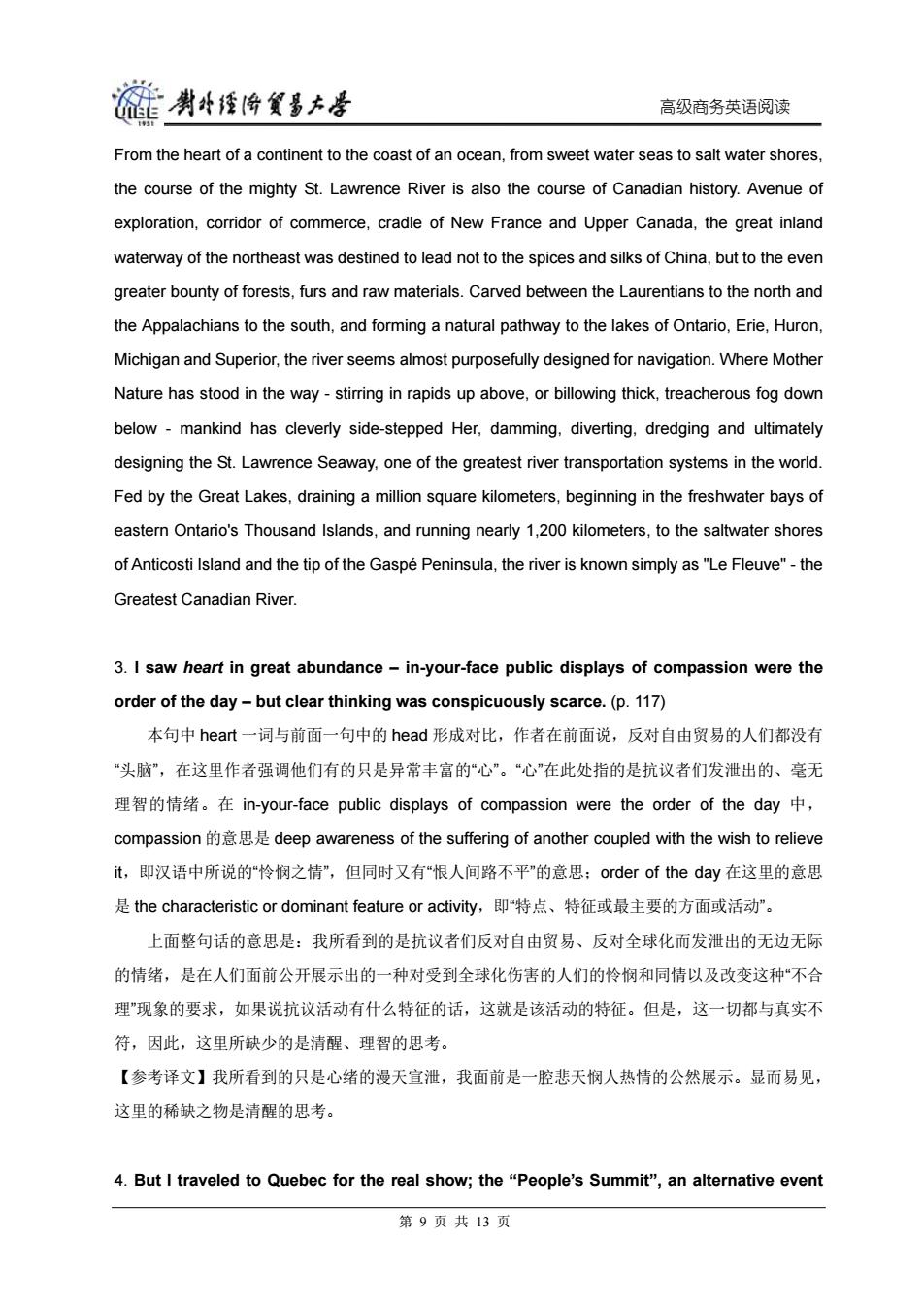
喇牛煙将多大是 高级商务英语阅读 From the heart of a continent to the coast of an ocean,from sweet water seas to salt water shores, the course of the mighty St.Lawrence River is also the course of Canadian history.Avenue of exploration,corridor of commerce,cradle of New France and Upper Canada,the great inland waterway of the northeast was destined to lead not to the spices and silks of China,but to the even greater bounty of forests,furs and raw materials.Carved between the Laurentians to the north and the Appalachians to the south,and forming a natural pathway to the lakes of Ontario,Erie,Huron, Michigan and Superior,the river seems almost purposefully designed for navigation.Where Mother Nature has stood in the way-stirring in rapids up above,or billowing thick,treacherous fog down below -mankind has cleverly side-stepped Her,damming,diverting,dredging and ultimately designing the St.Lawrence Seaway,one of the greatest river transportation systems in the world. Fed by the Great Lakes,draining a million square kilometers,beginning in the freshwater bays of eastern Ontario's Thousand Islands,and running nearly 1,200 kilometers,to the saltwater shores of Anticosti Island and the tip of the Gaspe Peninsula,the river is known simply as"Le Fleuve"-the Greatest Canadian River. 3.I saw heart in great abundance-in-your-face public displays of compassion were the order of the day-but clear thinking was conspicuously scarce.(p.117) 本句中heat一词与前面一句中的head形成对比,作者在前面说,反对自由贸易的人们都没有 “头脑”,在这里作者强调他们有的只是异常丰富的“心”。“心”在此处指的是抗议者们发泄出的、毫无 理智的情绪。在in-your-face public displays of compassion were the order of the day中, compassion的意思是deep awareness of the suffering of another coupled with the wish to relieve it,即汉语中所说的“怜悯之情”,但同时又有“恨人间路不平"的意思:order of the day在这里的意思 是the characteristic or dominant feature or activity,即“特点、特征或最主要的方面或活动”。 上面整句话的意思是:我所看到的是抗议者们反对自由贸易、反对全球化而发泄出的无边无际 的情绪,是在人们面前公开展示出的一种对受到全球化伤害的人们的怜悯和同情以及改变这种“不合 理”现象的要求,如果说抗议活动有什么特征的话,这就是该活动的特征。但是,这一切都与真实不 符,因此,这里所缺少的是清醒、理智的思考。 【参考译文】我所看到的只是心绪的漫天宣泄,我面前是一腔悲天悯人热情的公然展示。显而易见, 这里的稀缺之物是清醒的思考。 4.But I traveled to Quebec for the real show;the "People's Summit",an alternative event 第9页共13页
高级商务英语阅读 From the heart of a continent to the coast of an ocean, from sweet water seas to salt water shores, the course of the mighty St. Lawrence River is also the course of Canadian history. Avenue of exploration, corridor of commerce, cradle of New France and Upper Canada, the great inland waterway of the northeast was destined to lead not to the spices and silks of China, but to the even greater bounty of forests, furs and raw materials. Carved between the Laurentians to the north and the Appalachians to the south, and forming a natural pathway to the lakes of Ontario, Erie, Huron, Michigan and Superior, the river seems almost purposefully designed for navigation. Where Mother Nature has stood in the way - stirring in rapids up above, or billowing thick, treacherous fog down below - mankind has cleverly side-stepped Her, damming, diverting, dredging and ultimately designing the St. Lawrence Seaway, one of the greatest river transportation systems in the world. Fed by the Great Lakes, draining a million square kilometers, beginning in the freshwater bays of eastern Ontario's Thousand Islands, and running nearly 1,200 kilometers, to the saltwater shores of Anticosti Island and the tip of the Gaspé Peninsula, the river is known simply as "Le Fleuve" - the Greatest Canadian River. 3. I saw heart in great abundance – in-your-face public displays of compassion were the order of the day – but clear thinking was conspicuously scarce. (p. 117) 本句中 heart 一词与前面一句中的 head 形成对比,作者在前面说,反对自由贸易的人们都没有 “头脑”,在这里作者强调他们有的只是异常丰富的“心”。“心”在此处指的是抗议者们发泄出的、毫无 理智的情绪。在 in-your-face public displays of compassion were the order of the day 中, compassion 的意思是 deep awareness of the suffering of another coupled with the wish to relieve it,即汉语中所说的“怜悯之情”,但同时又有“恨人间路不平”的意思;order of the day 在这里的意思 是 the characteristic or dominant feature or activity,即“特点、特征或最主要的方面或活动”。 上面整句话的意思是:我所看到的是抗议者们反对自由贸易、反对全球化而发泄出的无边无际 的情绪,是在人们面前公开展示出的一种对受到全球化伤害的人们的怜悯和同情以及改变这种“不合 理”现象的要求,如果说抗议活动有什么特征的话,这就是该活动的特征。但是,这一切都与真实不 符,因此,这里所缺少的是清醒、理智的思考。 【参考译文】我所看到的只是心绪的漫天宣泄,我面前是一腔悲天悯人热情的公然展示。显而易见, 这里的稀缺之物是清醒的思考。 4. But I traveled to Quebec for the real show; the “People’s Summit”, an alternative event 第 9 页 共 13 页

雒剥经降置昌大号 高级商务英语阅读 organized ostensibly to represent-what else?-the 'people's views.'(I had assumed that the elected leaders at the Summit were there for that purpose,but who am I to question 'the people'?).(p.117) 作者这里的意思是说,参加“人民高峰会”的那些抗议者们本身就是人民,他们按照常理应该代表 “人民的意见”,但实际上并非如此。那些被选举出来的领导人(西半球34国首脑)参加“美洲高峰会” 正是为了人民的利益。因此,作者实际上是在说,那些所谓的“人民”代表不了“人民的意见”。说人民 代表不了人民自己似乎有勃于常理,因此,作者说自己怎能有资格向“人民”提出质疑呢? 5.Gracious to a fault,the Canadian government(i.e.Canadian taxpayers)funded the event and paid for Latin American activists to attend.(p.117) An innovation of the Quebec Summit was the invitation by the Canadian hosts to some 60 civil society organizations to enter the Summit conclave and to participate in a roundtable discussion with ministers.Many of the civic leaders voiced the same concerns being heard in the streets- that Latin American economies must do a better job at meeting the needs of the poor majorities. The exchange with ministers was polite and rather pro forma,but it set an important precedent that could further democratize hemispheric diplomacy.Civil society representatives can now demand a voice at the many ministerials and working groups that flow from the Summit process and that seek to implement the Summit mandates.Many clauses in the Summit's Plan of Action also call for inclusion of non-governmental groups in post-Summit activities. 6.Consider the following actual exchange I had with a startlingly well-fed young activist (who wore,naturally,imported jeans and sneakers).As she shook her flabby fist at me,a comrade filmed the exchange with a Japanese video camera that easily cost more than a year's salary for the average Latin American.(p.118) 本部分中,作者的一些话具有讽刺意味,如“startlingly well-fed young activist”"(保养得极好的年 轻激进分子),wore,naturally,imported jeans and sneakers”(自然穿着进口的牛仔裤和运动鞋), “she shook her flabby fist at me"(她向我挥动着的拳头,肌肉松弛,毫无力量。)以及"with a Japanese video camera'”(用一架日本摄象机)等。全球化的发展,国际间的贸易往来,促进了社会繁荣,使 人可以穿上进口的牛仔裤和运动鞋,购买价格昂贵的摄象机。即使是那些懒惰的人(如,那个肌肉 松弛,毫无力量的人)也可以保养得极好。作者此处意指:那些激进分子在从全球化中得到好处的 第10页共13页
高级商务英语阅读 organized ostensibly to represent – what else? – the ‘people’s views.’ (I had assumed that the elected leaders at the Summit were there for that purpose, but who am I to question ‘the people’?). (p. 117) 作者这里的意思是说,参加“人民高峰会”的那些抗议者们本身就是人民,他们按照常理应该代表 “人民的意见”,但实际上并非如此。那些被选举出来的领导人(西半球 34 国首脑)参加“美洲高峰会” 正是为了人民的利益。因此,作者实际上是在说,那些所谓的“人民”代表不了“人民的意见”。说人民 代表不了人民自己似乎有勃于常理,因此,作者说自己怎能有资格向“人民”提出质疑呢? 5. Gracious to a fault, the Canadian government (i.e. Canadian taxpayers) funded the event and paid for Latin American activists to attend. (p. 117) An innovation of the Quebec Summit was the invitation by the Canadian hosts to some 60 civil society organizations to enter the Summit conclave and to participate in a roundtable discussion with ministers. Many of the civic leaders voiced the same concerns being heard in the streets — that Latin American economies must do a better job at meeting the needs of the poor majorities. The exchange with ministers was polite and rather pro forma, but it set an important precedent that could further democratize hemispheric diplomacy. Civil society representatives can now demand a voice at the many ministerials and working groups that flow from the Summit process and that seek to implement the Summit mandates. Many clauses in the Summit’s Plan of Action also call for inclusion of non-governmental groups in post-Summit activities. 6. Consider the following actual exchange I had with a startlingly well-fed young activist (who wore, naturally, imported jeans and sneakers). As she shook her flabby fist at me, a comrade filmed the exchange with a Japanese video camera that easily cost more than a year’s salary for the average Latin American. (p. 118) 本部分中,作者的一些话具有讽刺意味,如“startlingly well-fed young activist”(保养得极好的年 轻激进分子),“wore, naturally, imported jeans and sneakers”(自然穿着进口的牛仔裤和运动鞋), “she shook her flabby fist at me”(她向我挥动着的拳头,肌肉松弛,毫无力量。)以及“with a Japanese video camera”(用一架日本摄象机)等。全球化的发展,国际间的贸易往来,促进了社会繁荣,使 人可以穿上进口的牛仔裤和运动鞋,购买价格昂贵的摄象机。即使是那些懒惰的人(如,那个肌肉 松弛,毫无力量的人)也可以保养得极好。作者此处意指:那些激进分子在从全球化中得到好处的 第 10 页 共 13 页